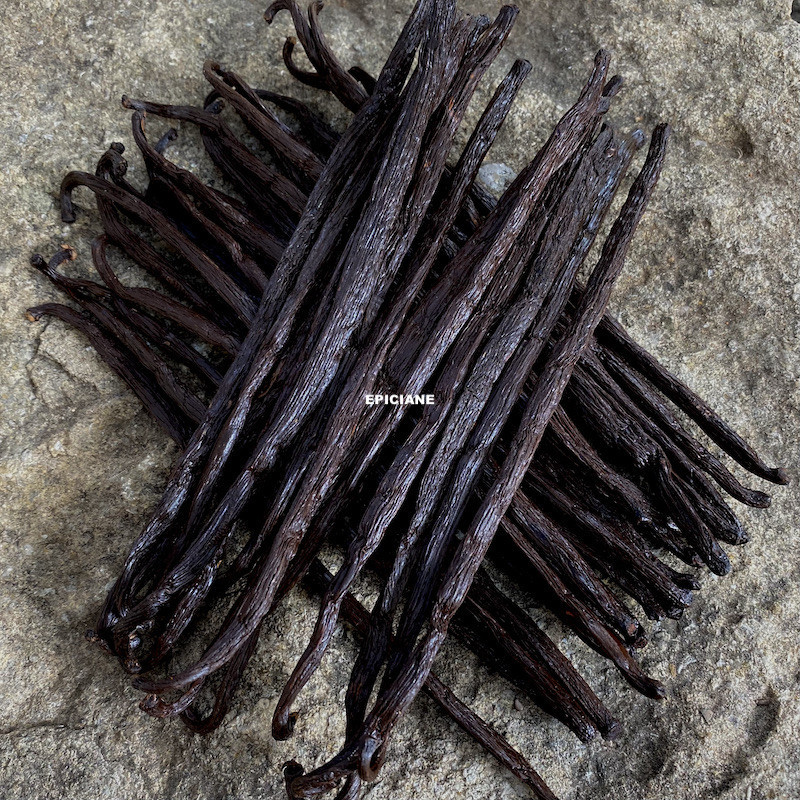
Reference: vanilletahitiE


The most renowned of all! The taste and aroma of this organic vanilla are rich, smooth, and very 'caramel-like.'
It will delight you in ice creams, compotes, jams, yogurts, and even in certain fish or seafood dishes.
 Delivery
Delivery
Mondial Relay
 Returns
Returns
See conditions
 Payments
Payments
100% secure
- Livrées sous sachet refermable -
Appearance:
Our organic vanilla beans are available in 16-20 cm lengths, each weighing approximately 4 grams.
Culinary Uses:
Vanilla is predominantly used in sweet recipes to flavor chocolate, ice creams, yogurts, jams, compotes, cakes, and cookies. It’s also found in Coca-Cola, cosmetics, and perfumes.
Interestingly, vanilla also enhances certain seafood and fish dishes, such as scallops, prawns, and lobster, adding a touch of elegance. It pairs excellently with white meats like veal.
Here are two ways to use vanilla beans:
For Sweet Dishes:
For Savory Dishes:
Vanilla aromas vary with species (such as planifolia and tahitensis), cultivation methods, and terroir. Vanilla's most characteristic and common aroma compound is vanillin.
Vanilla also has medicinal properties, and like chocolate, it’s known to improve mood.
Who am I? Cultivation?
Origin: Madagascar
Scientific name: Vanilla planifolia
There are two main types of vanilla: Planifolia (offered here) and Tahitensis.
Planifolia grows naturally in a small area of Central America, where it was discovered. Today, it is cultivated in Madagascar and Réunion, where it is known as “Bourbon vanilla.” Tahitensis is grown in Tahiti and Papua New Guinea, with shorter but thicker and heavier pods and a different aroma.
Vanilla is the fruit of a tropical vine orchid, the only orchid cultivated for purposes other than ornamentation. The cultivation and preparation of vanilla beans are time-intensive and meticulous, contributing to its high price. The plant grows in humid, tropical understory environments and is native to a small region in Central America.
The vine is flexible and easy to propagate, growing in the shade of trees up to 10 meters high, using aerial roots to cling to its support. Its fragrant white or pale yellow flowers can be up to 15 cm long and resemble typical orchid blooms.
Natural fertilization requires a specialized bee native to the Central American forests. As this pollinator wasn’t brought to other countries, flowers outside this region must be pollinated by hand each morning. This process, perfected in the 19th century by the slave Edmond Albius, made global vanilla cultivation possible.
After fertilization, the flowers transform into 12-25 cm pods over six weeks. Harvest occurs about nine months later, while still green to prevent the pods from splitting and losing their seeds.
After harvest, vanilla beans undergo a 10-month curing process. First, they are blanched in 63°C water, wrapped in wool blankets, and stored in large crates to sweat, which gives them a dark chocolate color. Then they are dried over 2-6 weeks, followed by an eight-month aging period. By the end, beans lose 80% of their weight. Finally, they are sorted by length, with the longest and thickest being the most prestigious.
High-quality beans should be pliable and may develop tiny, shiny white crystals of natural vanillin—a sign of quality, not to be confused with white/yellowish mold patches, which signal poor preservation and spoil the aroma.
In Madagascar, a tradition exists where young vanilla pods are "tattooed" with a distinctive mark by local producers to prevent theft.
"Bourbon vanilla" applies to beans from Madagascar, the Comoros, and Réunion. Other regions, such as Tahiti, also produce famous vanilla, but Bourbon vanilla remains the most widely produced and traded worldwide.
Vanilla cultivation is vulnerable to climate conditions, and frequent cyclones in Madagascar can significantly impact production and drive up prices.
Storage:
Keep vanilla beans dry, cool (e.g., in a refrigerator vegetable drawer), and shielded from light and air in a narrow jar or sealed test tube. Freezing is also an option to extend freshness.
Alternatively, you can store beans upright in a jar with a bit of alcohol to keep them moist. The beans will absorb a hint of alcohol, but they won’t dry out.
With proper storage, beans can remain fresh for many months.
A Little History:
The Aztecs, and earlier the Maya, used vanilla to flavor a thick cacao drink. The Aztecs obtained vanilla from coastal regions near present-day Veracruz, Mexico.
The Spanish discovered vanilla upon arrival in the Americas, bringing it to Europe in 1518. International trade took off in the 17th century when vanilla was introduced to Queen Elizabeth I of England.
Mexico retained its vanilla monopoly until the mid-19th century due to the need for a specific pollinator bee. King Louis XIV tried to grow vanilla on Île Bourbon (Réunion) without success until Edmond Albius invented a hand-pollination method in 1841. This innovation allowed vanilla cultivation beyond its native region, leading to global production.
In the late 1800s, Réunion farmers introduced vanilla to Madagascar, where Nosy Be and other eastern regions proved ideal for cultivation. Today, Madagascar produces 60% of the world’s vanilla, despite increasing competition from regions like India and Indonesia.
Data sheet
Reference: vanilletahitiE
Reference: OF35029
Reference: Papou
Reference: vanilletahitiE

The most renowned of all! The taste and aroma of this organic vanilla are rich, smooth, and very 'caramel-like.'
It will delight you in ice creams, compotes, jams, yogurts, and even in certain fish or seafood dishes.